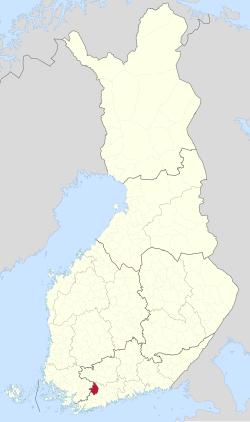
Espoo is a city in Finland, located to the west of the capital, Helsinki, in southern Uusimaa. The population of Espoo is approximately 314,000. It is the 2nd most populous city in Finland. Espoo is part of the Helsinki Metropolitan Area, which has approximately 1.58 million inhabitants.

Southern Finland was a province of Finland from 1997 to 2009. It bordered the provinces of Western Finland and Eastern Finland. It also bordered the Gulf of Finland and Russia.
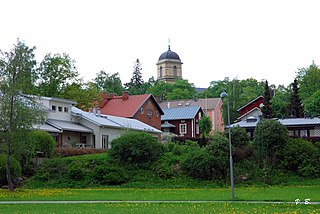
Vihti is a municipality located in the Uusimaa region of province of Southern Finland, approximately 50 kilometres (30 mi) northwest of the capital city Helsinki. The municipality has a population of 28,812 and covers an area of 567.06 square kilometres (218.94 sq mi) of which 45.02 km2 (17.38 sq mi) is water. The population density is 55.19 inhabitants per square kilometre (142.9/sq mi). Its seat is Nummela, which is the most populated urban area in the municipality.

Hollola is a municipality of Finland, located in the western part of the Päijänne Tavastia region. The municipality is unilingually Finnish and has a population of 22,887 and covers an area of 727.47 square kilometres (280.88 sq mi) of which 68.66 km2 (26.51 sq mi) is water. The population density is 35.13 inhabitants per square kilometre (91.0/sq mi).
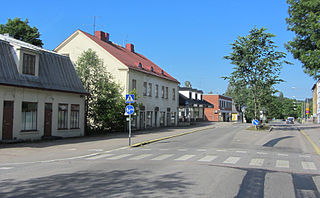
Karkkila is a town and a municipality of Finland.

Laukaa is a municipality of Finland. It is located next to Jyväskylä and is part of the Central Finland region. The municipality has a population of 18,750 and covers an area of 825.59 square kilometres (318.76 sq mi) of which 177.09 km2 (68.37 sq mi) is water. The population density is 28.91 inhabitants per square kilometre (74.9/sq mi).

Loppi is a municipality in Finland. It is located in the province of Southern Finland and is part of the Kanta-Häme region, located about 50 kilometers south of the city of Hämeenlinna. Loppi was founded in 1632. The municipality has a population of 7,694 and covers an area of 655.97 square kilometres (253.27 sq mi) of which 58.36 km2 (22.53 sq mi) is water. The population density is 12.87 inhabitants per square kilometre (33.3/sq mi). The municipality is unilingually Finnish.

Lohja is a city and municipality in the Uusimaa region of Finland. The city has a population of 47,518 (2017), and it covers an area of 1,109.73 square kilometres (428.47 sq mi) of which 91.78 km2 (35.44 sq mi), or 8.3 percent, is water. The population density of Lohja is 48.56 inhabitants per square kilometre (125.8/sq mi). The municipality is bilingual, with the majority being Finnish and minority Swedish speakers. Lohja has the fourth-most summer houses of any municipality in Finland, with 8,468 located within the city as of June 2018. Lohja is located near Greater Helsinki, and it benefits from a good road network. It takes less than an hour to drive from Helsinki to Lohja on the E18 motorway, which is one of the most significant main road connections in Lohja next to Hangonväylä.

Nummi-Pusula is a former municipality of Finland. It was merged with Lohja on 1 January 2013. Its seat was in Nummi. Nummi-Pusula was formed in 1981 from the former municipalities Nummi and Pusula.
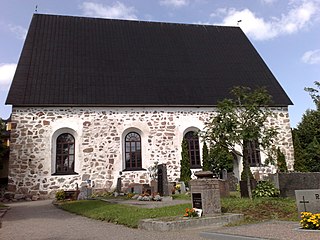
Siuntio is a municipality in the Uusimaa region of Southern Finland. Its neighboring municipalities are Ingå to the west, Kirkkonummi, to the east, Lohja to the north-west, and Vihti to the north. It is 46 kilometres (29 mi) west of Helsinki.
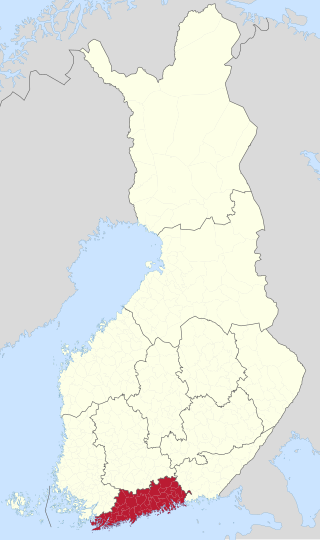
The Province of Uusimaa was a province of Finland from 1831 to 1997.
Nummi or NUMMI may refer to:

Saukkola is an urban area and district in the city of Lohja and the former administrative centre of the Nummi-Pusula municipality. Old Turku Road between Turku and Helsinki crosses through the area. Saukkola has a population of 1,034 inhabitants and is the second largest urban settlement in Lohja after the central urban area.

Lohja sub-region was a subdivision of Uusimaa and one of the Sub-regions of Finland. The sub-region was abolished in 2009 and merged into the Greater Helsinki.

Äänekosken maalaiskunta is a former municipality of Finland in the Central Finland region. It was consolidated with the kauppala of Äänekoski in 1969.
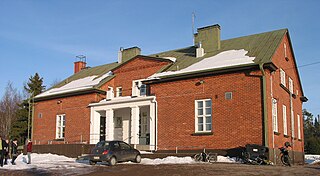
Pusula is a village in the city of Lohja in Uusimaa, Finland. It was former administrative center of the former Pusula municipality. It has over 700 inhabitants. Lake Pusula is located on the southern edge of the village.
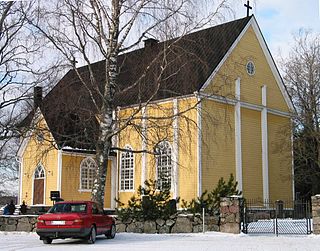
Pusula Church is a wooden church located in the Pusula village in Lohja, Finland. The church was designed by Carl Ludvig Engel and it was built by master builder Henrik Andsten. The church was completed in 1838. After its completion, structural problems appeared in the church, as its walls could not withstand the weight of the roof, so the roof had to be lowered by 8 meters. The repair work was done in 1858-59.
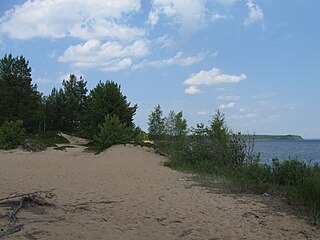
Manamansalo is the largest island in the Oulujärvi, the fifth largest lake in Finland. Administratively it belongs to the Vaala municipality in North Ostrobothnia, or Kainuu until 2016. It is the seventh largest inland island in Finland, or the fifth largest if Soisalo and Sääminginsalo are not counted as islands.
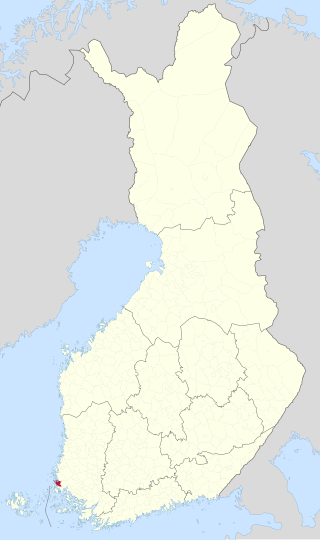
Lokalahti is a village and a former municipality of Finland in the former Turku and Pori Province, now in the Finland Proper region. It was consolidated with the town of Uusikaupunki in 1981.

